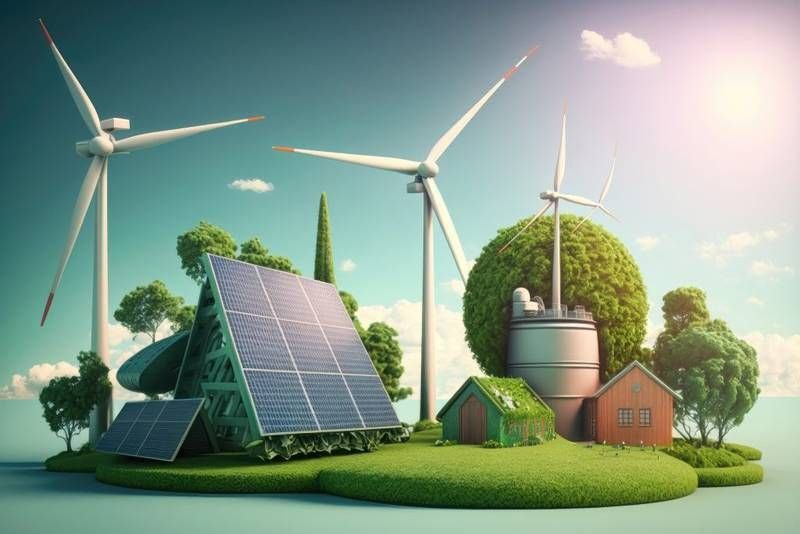Investing in Renewable Energy: Beyond Solar and Wind Trends & Benefits

Investing in renewable energy: beyond solar and wind offers exciting opportunities for renewables investors, climate change investments, power generation, and sustainability deals. While solar panels and wind turbines steal the spotlight, other renewable energy solutions and sustainable energy sources deserve attention, including renewable energy development projects and clean energy generation. Geothermal, hydroelectric, and biomass energy are gaining traction. They provide unique advantages through solar energy projects and wind energy, and can diversify your investment portfolio with solar capacity aligned with the America agenda. These alternatives not only contribute to a sustainable future on the agenda but also promise solid returns. Understanding these options is crucial for savvy investors. Explore how these lesser-known sources can enhance your strategy and make a real impact on the planet.
Key Takeaways
- Explore investments in diverse renewable energy sources like geothermal, biomass, and hydropower for a well-rounded portfolio.
- Stay informed about emerging trends in clean energy, such as energy storage and electric vehicle integration, to capitalize on future opportunities.
- Consider the long-term economic benefits of investing in clean energy, including job creation and energy cost savings.
- Engage with local governments and organizations to support policies that promote clean energy initiatives in your community.
- Analyze case studies of successful clean energy projects to understand best practices and potential challenges.
- Monitor technological advancements that can enhance efficiency and reduce costs in renewable energy sectors.
Building a Thriving Clean Energy Economy
Biden’s Agenda
President Biden’s Investing in America agenda plays a crucial role in promoting clean energy. It aims to transition the country towards a sustainable energy future. This includes initiatives that support the clean energy sector. The goal is to create jobs and stimulate economic growth.
Financial Commitments
Significant financial commitments come from recent legislation. The Bipartisan Infrastructure Law allocated billions for clean energy projects. The Inflation Reduction Act further emphasizes this commitment by providing incentives for renewable energy technologies. These laws aim to reduce carbon emissions and enhance clean energy deployment across the nation.
Long-Term Certainty
The Inflation Reduction Act offers long-term investment certainty. This stability encourages private sector participation in the clean energy revolution. Businesses can confidently invest in renewable energy projects, knowing they have government support. This fosters innovation within the booming renewables sector.
Clean Energy Supply Chain
Investment in the clean energy supply chain is essential. It ensures that raw materials and components for renewable energy generation are readily available. Strengthening this supply chain will help meet the growing demand for clean energy solutions.
Future Outlook
The renewable energy outlook remains positive. As more states adopt ambitious climate goals, the clean energy industries will grow. This growth will lead to more opportunities in clean energy manufacturing and deployment.
Key Segments Beyond Solar and Wind
Energy Storage
Advancements in grid energy storage technologies play a vital role in energy resilience. These innovations help manage fluctuations in energy supply and demand. For instance, battery storage systems allow for excess energy generated during peak solar or wind production to be stored for later use. This improves the overall efficiency of renewable technologies.
Electric Vehicles
The growth of electric vehicles (EVs) represents a significant segment in the clean energy market. Projections indicate that EV adoption will continue to rise, driven by private companies investing in battery technology. The increase in EVs can reduce dependence on fossil fuels and lower greenhouse gas emissions. As more consumers choose electric vehicles, the demand for charging infrastructure will also grow.
Emerging Sources
Emerging renewable energy sources like geothermal, tidal, and biomass offer additional opportunities. Geothermal energy harnesses heat from beneath the Earth’s surface. Tidal energy captures the power of ocean tides. Biomass utilizes organic materials for fuel. Each of these sources contributes to diversifying the renewable energy sector and increasing overall capacity.

Trends Driving Clean Energy in 2023
Electric Vehicles
Rapid growth in electric vehicle (EV) sales marks a significant trend. In 2022, global EV sales reached over 10 million units. This surge reflects a shift toward cleaner transportation options. The increase in EV adoption drives demand for clean energy. As more consumers choose electric cars, the need for renewable energy sources rises.
Battery Storage
Dramatic expansion occurs in grid-connected battery energy storage capacity. In 2023, the U.S. aims to install over 30 gigawatts of battery storage. This technology helps balance supply and demand in the energy market. It also supports the integration of more renewable energy sources. Efficient battery storage is crucial for achieving climate goals.
Solar Manufacturing
The Inflation Reduction Act has spurred a surge in planned manufacturing capacity for solar module assembly. Companies plan to invest billions into solar manufacturing facilities across the U.S. By 2025, this could result in a doubling of domestic solar production capacity. Increased local production will help meet global energy needs and reduce reliance on imports.
These trends highlight a clear agenda for clean energy development in the coming years. Investment in EVs, battery storage, and solar manufacturing aligns with broader climate change initiatives. The focus remains on achieving ambitious clean energy goals while addressing environmental challenges.
Economic Benefits of Clean Energy Investments
Climate Goals
Clean energy investments play a crucial role in achieving climate goals. They help reduce greenhouse gas emissions significantly. This reduction is vital for combating climate change. By investing in renewable energy resources, countries can lower their reliance on fossil fuels. This shift enhances energy security. It ensures a stable supply of power while reducing vulnerability to price fluctuations.
Economic Growth
Strong investments in manufacturing and construction boost economic growth. The renewable energy sector requires substantial infrastructure development. This demand creates numerous projects that stimulate local economies. For instance, building wind farms or solar facilities involves various materials and labor. As a result, the private sector sees increased activity and profit opportunities.
Job Creation
Job creation is another significant benefit of clean energy technologies. The deployment of these technologies leads to new employment opportunities across several sectors. Green energy companies often require skilled workers for installation, maintenance, and operation. According to the International Renewable Energy Agency (IRENA), the renewable energy sector employed over 11 million people globally in 2018, with numbers continuing to rise.
Investments in clean energy not only drive innovation but also foster a sustainable future. They create jobs and enhance local economies while addressing environmental challenges.
Closing Thoughts
Investing in renewable energy goes beyond just solar and wind. You have a wealth of opportunities to explore, from geothermal to bioenergy. These sectors not only promise growth but also contribute to a sustainable future. Embracing these alternatives can lead to significant economic benefits for you and your community.
Now is the time to act. Dive into these emerging markets and make informed decisions that align with your values and goals. The shift toward clean energy is not just a trend; it’s a necessity for a thriving planet. Equip yourself with knowledge and take the leap into renewable investments that can shape a better tomorrow for all.
Frequently Asked Questions
What are the main segments of renewable energy beyond solar and wind?
Key segments include geothermal energy, hydropower, biomass, and hydrogen fuel. Each offers unique advantages and contributes to a diversified clean energy portfolio.
Why should I invest in renewable energy?
Investing in renewable energy supports sustainability, reduces carbon footprints, and can yield significant financial returns as demand for clean solutions grows globally.
What trends are shaping the clean energy market in 2023?
Trends include technological advancements, increased government incentives, corporate sustainability commitments, and a shift towards decentralized energy systems.
How does investing in renewable energy benefit the economy?
Renewable energy investments create jobs, stimulate local economies, reduce energy costs, and enhance energy security, leading to long-term economic growth.
Is renewable energy investment risky?
Like any investment, there are risks involved. However, growing demand and supportive policies make renewable energy a relatively stable sector with potential for high returns.
Can individuals invest in renewable energy projects?
Yes, individuals can invest through green bonds, crowdfunding platforms, or by purchasing shares in renewable energy companies. This democratizes access to clean energy investments.
How do I choose the right renewable energy investment?
Research is key. Consider factors like market trends, technology viability, regulatory environment, and your personal investment goals to make informed decisions.
 Send Buck a voice message!
Send Buck a voice message!




